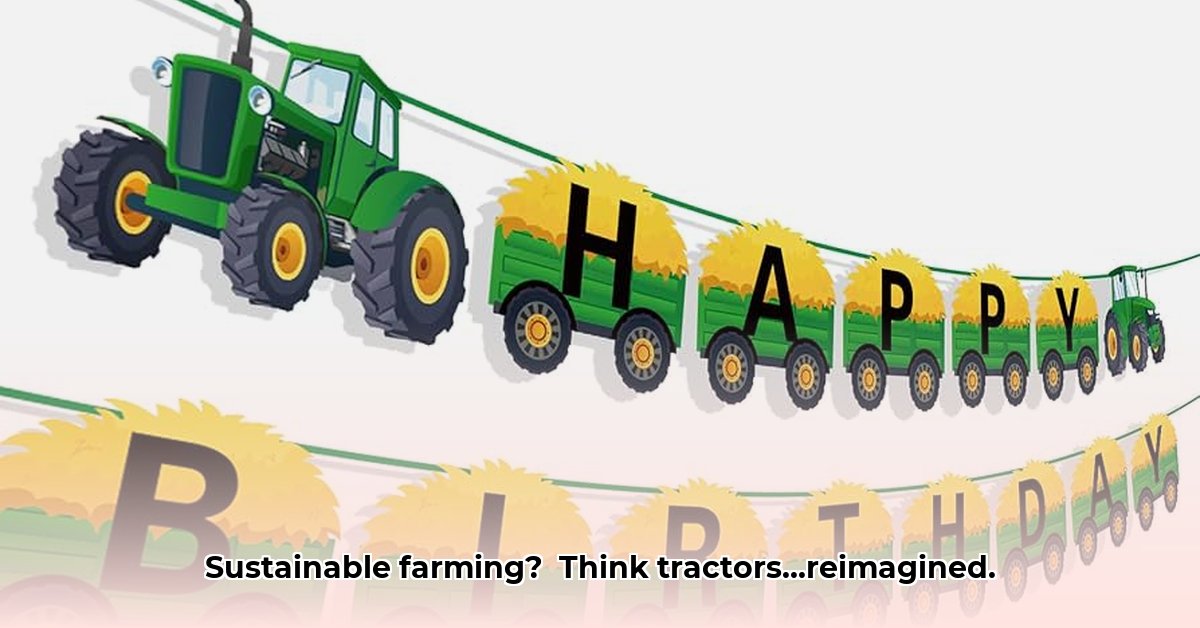
Beyond the Machine: Farm Equipment as a Brand Story
For years, tractors and other farm equipment have been viewed solely as tools. But what if these machines could also communicate a farm's values and connect with consumers? The visual presentation of a farm – encompassing everything from tractor paint jobs to signage and packaging – is becoming increasingly important, particularly for those committed to sustainable practices. Consider your farm a brand, a narrative woven into every piece of equipment and every product. What message do you want to convey? Is it one of environmental stewardship, community engagement, or perhaps a commitment to ethical labor practices? The way your farm looks is now as vital as its functionality, especially when showcasing sustainable farming. For more ideas on tractor colors, check out this helpful resource: Tractor Color Ideas.
Painting a Picture of Sustainability: Visuals That Speak Volumes
Imagine a tractor, not simply a standard color, but adorned with a vibrant mural illustrating the farm's commitment to organic methods. Or perhaps, solar panels seamlessly integrated into the design, vividly signaling the farm's dedication to renewable energy. The possibilities are endless! Think of the powerful message conveyed by clearly visible, easily readable signs proudly displaying certifications, such as "Certified Organic," "Fair Trade," or "Water Conservation Practiced Here." Custom paint jobs, striking logos on equipment, even an aesthetically pleasing tool shed – all contribute to a cohesive brand image that communicates "eco-conscious" values. This transcends mere decoration; it's a potent marketing strategy.
A recent study by the USDA showed a correlation between a farm's visual presentation and consumer perception of its sustainability efforts, suggesting the potential for increased sales and market share. This underscores the importance of investing in visual communications to support sustainable practices.
Branding Your Sustainable Farm: More Than Just a Pretty Face
Effective visual communication is not just about aesthetics; it's about strategically and cleverly conveying a farm's unique story. Today’s consumers actively seek information; they want to know the origin of their food and the methods used in its production. A strong visual identity fosters trust. Consumers are more likely to support farms they perceive as transparent and understand.
Key Branding Elements:
Signage: Clear, concise signs are vital. Highlight your sustainable processes prominently and succinctly. Phrases like "Locally Grown," "No Pesticides," and "Ethically Sourced" resonate powerfully.
Equipment: Consider custom paint schemes, memorable logos, or even handcrafted decorations on your tractors. This visual branding reinforces your commitment to sustainability.
Packaging: Employ eco-friendly, visually engaging packaging. The packaging itself tells a story; ensure it's a compelling one that reflects your values.
Online Presence: Utilize high-quality photos and videos on your website and social media platforms. Show, don't just tell. Images of contented animals, flourishing fields, and thriving crops speak volumes.
Success Story: The "Happy Hens" Farm
"Happy Hens" Farm, a small organic egg producer, provides a compelling example. Initially utilizing plain equipment, they underwent a rebranding initiative. They repainted their tractors with bright, inviting designs featuring their hens, created custom egg cartons with charming illustrations, and developed a lively, informative website showcasing their commitment to animal welfare and sustainable farming methods. The result? A remarkable surge in brand recognition and sales. Their customers connected with the story they conveyed – and the eggs were delicious too!
"Rebranding completely changed our customer engagement," says Sarah Miller, owner of Happy Hens Farm. "People are drawn to the story we tell through our visuals, and that translates directly to increased sales."
The Challenges (and How to Overcome Them)
While the advantages of visual branding are evident, obstacles exist. The initial investment in repainting equipment or creating new signage can be a significant expense for smaller farms. Many farmers might also lack design expertise. However, practical solutions are available:
Collaboration: Partner with local artists or design students. You might discover talented individuals eager to collaborate on projects in exchange for experience or a mutually beneficial arrangement.
Funding: Research grants or government programs supporting sustainable agriculture. Many organizations offer funding for marketing and branding efforts.
DIY: Embrace your creativity! Homemade decorations, repurposed materials, and inventive signage can be surprisingly effective and cost-conscious.
Your Step-by-Step Guide to Visual Branding Success
This process can be broken down into manageable steps:
Define Your Brand Story: What distinguishes your farm? Which values do you wish to emphasize?
Develop Your Visual Identity: Select colors, imagery, and a style accurately reflecting your brand and farming methods.
Create a Style Guide: Maintain consistency across all marketing materials and on your equipment. This ensures a unified brand message.
Implement Gradually: Introduce your new branding progressively. Begin with one piece of equipment or a section of your farm and expand from there.
Track Your Progress: Monitor consumer engagement and sales. Utilize various analytics tools and customer feedback to assess the effectiveness of your visual branding strategy.
The Growing Importance of Farm Aesthetics
The future of farming increasingly depends on effectively communicating its practices. From carefully designed signage to eye-catching tractor decorations and compelling packaging, visual branding is no longer merely an aesthetic concern; it is a powerful tool for building trust, sharing your unique story, and ultimately, achieving greater success in sustainable agriculture. It’s about forging deeper connections with your customers, establishing a strong brand identity, and ensuring your farm thrives for generations to come. The visual appeal of your farm plays a far greater role than you may realize.